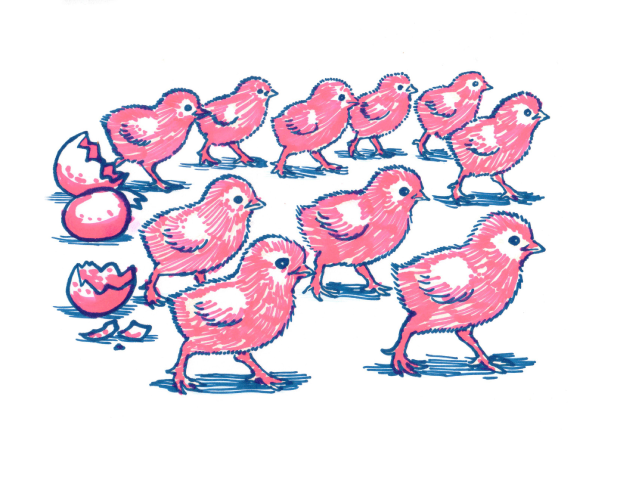The Compton Comeback
How a school district’s success is impacting an entire city’s reputation—and how the city is supporting its schools


The Compton Comeback
How a district is transforming an entire city’s
reputation—and how the city supports its progress
In the late 1980s and early ‘90s, rap group N.W.A.’s raw depictions of street life put Compton, California, on the national stage—but for all the wrong reasons. The city became synonymous with gang violence. At the same time, Compton Unified School District (CUSD) was in decline and in need of new leadership to turn it around. But the city’s reputation made it difficult to recruit the kind of exceptional leadership the district needed.
In fact, the city’s reputation almost prevented Superintendent Dr. Darin Brawley from applying for the top job at CUSD. “You hear the notorious name ‘Compton,’ and all these ideas come to mind. When I saw the job posting for the first time, I thought, I’m not interested in that,” he says. The district he would inherit had nearly filed for bankruptcy, teetered on the brink of a second state takeover and watched student proficiency rates lag far behind state averages.
Not surprisingly, the role wasn’t filled right away. When Brawley saw the listing again, curiosity got the better of him, and he decided to investigate. “I started to dig into the scores, and I saw that the elementary schools in general were doing okay. Some were well-performing or were middle-of-the-road. I saw that as an interesting challenge,” Brawley says. After all, he had experience improving academic performance at his previous district. He could see a bright future for these kids in the early stages of learning—as long as they were given the right tools and support.
He also found the city of Compton wasn’t as he first thought. “When I got here, I realized it’s just like any other city. The people who live here really care a lot about their city and want the best for the students we serve,” says Brawley. Ultimately, it didn’t matter whether the chicken or the egg came first—the city’s struggles reinforced the school district’s negative reputation, and poor educational outcomes became another data point used against the city.
Brawley had the potential to break the cycle by focusing on CUSD students. He wanted to change the narrative about Compton and put it on the map for student success. In 2012, he joined the district to do just that.
How The District is Changing
Before Brawley could make any significant changes, he had to ensure the district was financially solvent. In order to save pennies, he took a microscope to expenses big and small, from staff contracts to light bulbs. While Brawley was cutting costs, California was considering a new school funding formula that would award districts extra money for English learners, foster children and students from low-income households. The result was an extra $5,000 per pupil in unrestricted funds. It added up: At CUSD, 92% of students are economically disadvantaged. The district was a beneficiary of ESSER funding as well, which Brawley used wisely to acquire hundreds of new tutors and coaches, among other things (more on that later).
With the district out of the red, Brawley could concentrate on improving student academic performance. In addition to reading and math scores, he began monitoring additional key performance indicators like graduation rates, college preparation, absenteeism and suspension rates. “We benchmark our performance against our surrounding districts, and we have established SMART goals we want to work towards,” he says. Brawley keeps a very close eye on these data points—tracking changes week to week—and reviews progress with site leaders every six weeks.
As part of Brawley’s plan, students began taking frequent exams to get them comfortable with testing and to target weak spots. Students who needed them were provided tutors to address problem areas. The district also placed learning coaches in classrooms to provide help on the spot, and boosted math and reading training for teachers. Based on the data, English learners in particular were falling behind, so Brawley hired bilingual instructional assistants, established dual-language immersion programs and opened welcome centers for immigrant families.
Now, CUSD is outperforming surrounding districts in almost every category. Students in Compton are scoring more than half a grade level better in math than in 2019 and nearly half a grade level better in reading. The district’s graduation rate soared from 58% to 93%. Their A through G completion rates also skyrocketed. (In California, A through G refers to high school courses students must pass in order to be eligible for enrollment at the University of California and California State University systems.) Under Brawley’s leadership, overall completion rates jumped from 12% to almost 70%. And nearly 50% of CUSD’s Latine graduates, whose completion rates have historically been much lower than the rest of the student body, now meet the state’s minimum college admissions requirements.
Brawley wanted to do more than improve academic performance, though. He wanted to expand learning and job opportunities for his students—by providing a more robust STEAM education. “I took some of my management team to visit Apple and Google a few years ago. And I saw there was no representation at Google that looked like anyone in Compton. There weren’t any Black or Mexican employees,” he says. “I left that place with a mission: By the time kids graduated from CUSD, they would have the skills they’d need to take advantage of those kinds of jobs.”
The district won an Apple ConnectED grant for five of its schools, which provided iPads for every student, technology labs, and professional development opportunities for employees. Since then, 15 sites have also become Verizon Innovative Learning Schools. “So that further cemented some of the stuff that we were doing in the area of technology for students. Verizon has been amazing in terms of the investment they poured into the school district, providing one-to-one devices, technology labs and a 5G network,” Brawley says.
The district also secured partnerships with LEGO and Boeing among others. And thanks to Brawley’s focus on STEAM education, students can start coding, building robots and playing esports as early as preschool. They can compete in engineering and drone competitions, attend summer technology camp, and receive first-class preparation for an increasingly tech-centered world.

Despite remarkable progress at his district, Brawley acknowledges that changing decades-old perceptions remains a challenge. “Some people would still choose to send their kid to an underperforming charter school rather than a school in Compton that’s producing excellent results,” Brawley notes. “They’re still hanging on to their idea of what Compton was.”
How the City Supports the District
The city of Compton’s mayor, Emma Sharif, on the other hand, believes the district’s improvements are already making a big difference in how the rest of the world sees their community. “Our students are going to colleges all over the world. We have a young girl graduating this year who’s going to Cornell,” she says. “That, to me, is saying a lot about the city of Compton.” The city’s aim is to amplify and sustain the positive perception of Compton that CUSD is helping to shape—which, of course, will require the city to make some changes of its own.
Around the same time Brawley joined the district, the city was installing its own change-maker in the mayor’s office—the youngest in its history, 31-year-old Aja Brown. She envisioned her hometown becoming a “new Brooklyn,” transforming from a place known for violence into one recognized for opportunity and success. She began her work by facilitating conversations between two rival gangs, the Bloods and the Crips, to negotiate peace. At the same time she recruited rappers like Dr. Dre (a former member of N.W.A.) and Kendrick Lamar, as well as tennis stars Serena and Venus Williams, to be poster adults for what Compton kids could become.

In 2021, Emma Sharif succeeded Brown in the mayoral office and continued to build upon the positive momentum. A former CUSD teacher and board member, she believes that city initiatives should complement the work the district is doing. And by helping its children, the city is helping its own reputation.
The most important part the city plays in supporting the district is supporting the health and well-being of its students. A majority of a student’s waking life is still spent outside of school, which is where a city can step in. “When young people lack access to meaningful activities and support, they are more likely to get into trouble. Youth programs that we offer here in the city really do help reduce crime rates in our community,” Sharif explains. Through planned improvements to public parks, the city will ensure students have safe, engaging places to spend time after school and on weekends. The city provides free swimming lessons at city pools, sports clinics, field trips and camps to keep kids active during the summer.
Compton also provides emotional support for its young residents through its Youth and Family Counseling initiative. The program offers assessments, lessons on preventive coping skills, social-emotional workshops and group counseling services for youth and their families—all at no cost. “Millions of students across America are affected by mental illness, with 1 out of 5 students suffering from some form,” the city’s website states. “Most students go untreated because they either cannot afford care, lack access, or do not know where to turn for help. The Youth and Family Counseling initiative aims to bridge care gaps for the most vulnerable youth.”

And the city has a vested interest in helping the district prepare students for life after school. “Our youth are the future of our city. We’re looking to the next generation to step into our roles,” Sharif says. Her hope is that CUSD graduates will become homeowners, business owners and taxpayers in the community. She even hopes future CUSD grads will take her role someday and run city government. “The district is producing citizens that can continuously contribute to the overall success of the city and our economic growth,” she says.
Sharif recognizes the importance of collaboration in meeting that goal. That’s why she organized meetings between city government officials, CUSD and Compton Community College to find ways to partner on projects like a combined job fair. “We came together and did a one-stop shop. People could look for jobs with the city, college, and the district and submit their applications right there,” says Sharif. In the past year, the city has also offered a financial literacy summit and partnered with a local nonprofit to provide scholarships and an extended series of career pathway workshops—providing insights into and training for a variety of careers. The city is even working with CUSD to provide residents with affordable housing. Because the district is the largest landowner in the city, they are in the planning stage of building affordable housing on district property.
Lastly, the city is reinforcing the district’s work by amplifying its successes. For instance, when Director of Communications John Stouffer wanted to hang CUSD banners off campus, Sharif offered prime real estate. “We hung eight banners across the city in key intersections. We’re also doing light post banners, which will be up in the next month,” Stouffer says. The city and district even cross-post job openings on their websites. And of course, in interviews such as this one, Sharif is always quick to sing the district’s praises.

How Both Benefit
Sharif thinks that the key to turning Compton’s reputation around is embracing the city’s complex history. “I always take a look at the positive side of the achievements of artists like Dr. Dre and Eazy-E. They’re really part of Compton’s DNA. I don’t believe we need to distance ourselves from that. I think we need to expand on the narrative,” she explains.
The city is adding new chapters to its story, cowritten by CUSD, about students graduating high school with associate degrees, attending college, going to work in Silicon Valley and starting their own businesses in the place where they grew up. Even if they don’t return, says Mayor Sharif, they are changing the perception of Compton wherever they go. “The young people carry Compton in their hearts,” she says. “When they go places, people see us. They see how we carry ourselves here.”
Brawley, ever the pragmatist, still sees room for improvement at the district and city levels. “We’ve accomplished a lot as a school district, but we’ve only touched the surface in terms of what’s possible. The city is also in the process of trying to change,” he says. But they both have come a long way already. In fact, Brawley has been with the district long enough now to see those elementary school students—the ones who convinced him to take the job in the first place—graduate and go to Ivy League schools. And as Sharif says, when they go places, people see the whole city in a new light.
Compton’s comeback is proof that school districts and their local communities don’t operate in isolation—their successes and therefore their reputations are inextricably linked. When schools deliver excellent results for their students and a city supports its schools, they both are the better for it.


